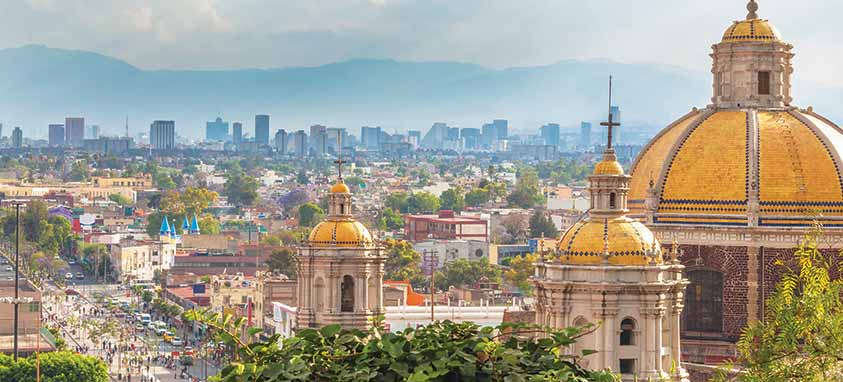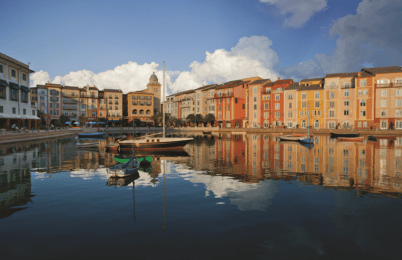Aerial view, Mexico City
Although Central Mexico is devoid of the azure beaches that make Riviera Maya appealing to meeting planners, it has other outstanding attributes. Colorful and cosmopolitan, the region pulsates with energy. A plethora of historic buildings provide interesting offsite options.
Getting to the urban centers of Mexico City, Guadalajara and Puebla is a breeze. Mexico City Benito Juarez International Airport (MEX) operates more than 1,000 daily flights. Airlift to Guadalajara International Airport (GDL) is also convenient, with 23 direct flights from the United States. Puebla International Airport (PBC) offers direct flights from Houston, with connections to other North American locations.
Mexico City
Named No. 1 on The New York Times’ list of 52 Places to Go in 2016, Mexico City welcomes more than 12.5 million visitors annually. The geographically sprawling metropolis is the political, financial, economic, academic and social center of the country.
As a major gateway to Latin America that also borders the United States, Mexico City is a popular choice for international conferences. Thousands of conventions and trade shows occur annually in its four main congress venues—World Trade Center Mexico City, Expo Reforma, Centro Banamex and Expo Bancomer Santa Fe. The resource-rich city provides more than 49,000 guest rooms and 3,000 restaurants.
“From modern convention centers and hotels to historic and exciting venues, Mexico City offers settings to host meetings of all sizes,” says Armando Lopez Cardenas, general director of Fondo Mixto de Promocion Turistica de la Ciudad de Mexico.
Offsites can be arranged in stately buildings. Casino Espanol de Mexico, a stunning private palace in the city center, can seat 500 guests. Ex Convento de San Hipolito, a dramatic 16th-century structure restored to its original glory, boasts a lovely courtyard that can accommodate 1,200 for dinner.
Accommodations are plentiful. The St. Regis Mexico City, situated in the exclusive Paseo de la Reforma neighborhood, features 189 guest rooms, more than 10,000 sq. ft. of meeting space and an indoor pool with panoramic city views. In the upscale Polanco neighborhood, W Mexico City offers 237 guest rooms and 7,700 sq. ft. of meeting space. The five-star Four Seasons Hotel Mexico, D.F. recently completed $14 million worth of updates to its 240 guest rooms and 12,084 sq. ft. of meeting space. The Ritz-Carlton will make its debut in Mexico City with a 153-room property slated to open in 2019.
Guadalajara
Guadalajara, capital of the state of Jalisco, is Mexico’s second-largest city. Although it has historic Colonial plazas, the modern business center is sometimes referred to as Mexico’s Silicon Valley.
“Guadalajara is a city of folklore, colors and contrasts, where the modern mingles with history, culture and Colonial architecture—a place whose mariachis, tequila and traditional hospitality are its best emblems,” says Gustavo Staufert, director of Guadalajara Office of Visitors and Conventions.
The city is actively growing its convention business. Staufert notes that it hosted the 2016 World Ophthalmology Congress in February, drawing more than 8,000 attendees. Most congresses take place at Expo Guadalajara, a two-level, state-of-the-art convention center with 984,400 sq. ft. of flexible exhibition and meeting space.
Hotel development is booming; more than 2,000 guest rooms will be added to the city’s inventory by the end of 2016. New properties include AC Hotel Guadalajara, with 173 guest rooms and 3,057 sq. ft. of meeting space, and Hyatt Regency Andares Guadalajara, a 220-room property with almost 29,000 sq. ft. of indoor and outdoor meeting space, including a 2,500-square-foot ballroom and 10 breakout rooms.
Guadalajara boasts many unique event venues. Cabanas Cultural Institute is a UNESCO World Heritage Site housing the work of muralist Jose Clemente Orozco. It can accommodate 1,300 for a banquet; the auditorium holds 2,500. The recently renovated neoclassical Teatro Degollado downtown was founded in 1866. The elegant theater, home of Jalisco Philharmonic Orchestra, seats 1,000.
Puebla
Puebla, located two hours southeast of Mexico City, has a pleasant year-round climate and dramatic views of nearby volcanoes. The city has a modern infrastructure and excellent convention venues. The new Puebla Exhibition Centre offers 430,556 sq. ft. of space while Centro Expositor Puebla boasts 430,400 sq. ft. of exhibition space. University Cultural Complex has an indoor auditorium that can accommodate 3,494 and an outdoor plaza with seating for up to 15,000. Centro de Convenciones Puebla in the city center offers 96,875 sq. ft. of event space, including a function hall that can hold 3,500 people.
The five-star Camino Real Puebla Angelopolis has 153 guest rooms, 41,376 sq. ft. of meeting space and an 18-hole golf course designed by Jack Nicklaus. Presidente InterContinental Puebla features 166 guest rooms and eight meeting rooms with a total capacity for 600.
Explore
Tequila Express Tour

Many of Mexico’s best tequila distilleries are located in the Guadalajara countryside. Learn more about how Mexico’s signature spirit is crafted on an excursion that includes a tour of the Herradura factory, buffet lunch, folkloric ballet performance and mariachi entertainment. Unlimited shots of tequila are included.
Casa Azul, Museo Frida Kahlo

Artists Frida Kahlo and Diego Rivera lived in Kahlo’s family home in Mexico City, Casa Azul (Blue House). It has been transformed into a museum that contains folk art and personal artifacts that belonged to the couple. The bright blue building is a fine example of early 20th-century Mexican architecture.
Chiles en Nogada

Chiles en nogada originated in Puebla. It consists of poblano chili peppers filled with shredded meat, fruits and spices, and topped with a walnut-based cream sauce and pomegranate seeds. The popular dish contains the three colors of the Mexican flag: green chilis, white cream sauce and red pomegranate seeds.
Must See

Lucha libre is a form of professional wrestling that differs from traditional wrestling in that the athletic luchadores perform aerial maneuvers, using the ring’s ropes to catapult themselves toward opponents. They also sport elaborate masks. That tradition began in 1942, when luchador El Santo stepped into a Mexico City ring wearing a simple silver mask, instantly enchanting the public with his mystique.
Over his five-decade career, El Santo became a popular national hero, featured in comic books and movies. The masks today are far more complex than El Santo’s, often portraying animals, gods and other archetypes whose identities the luchadores take on during performances. Visitors can attend lucha libre matches in cities throughout Mexico




